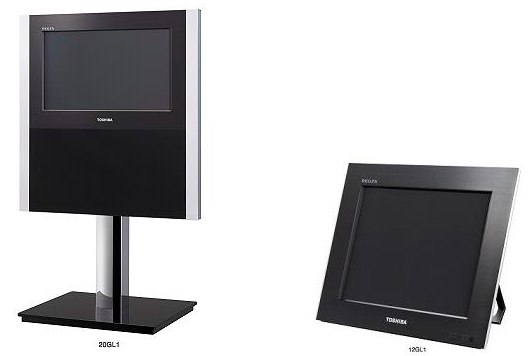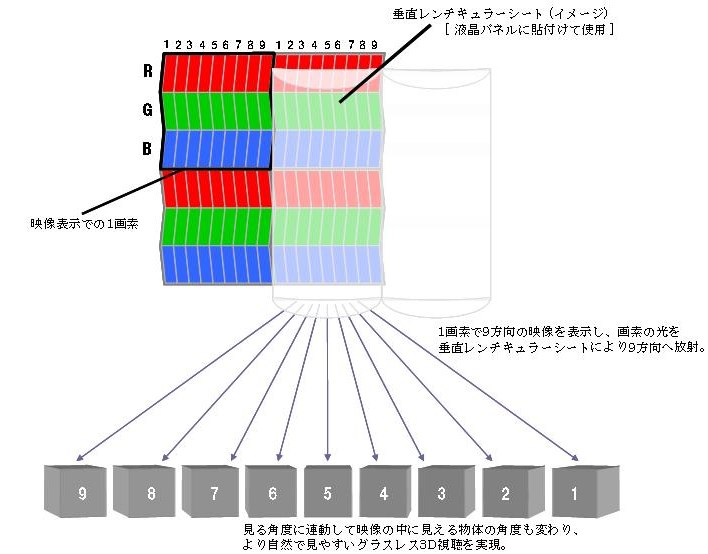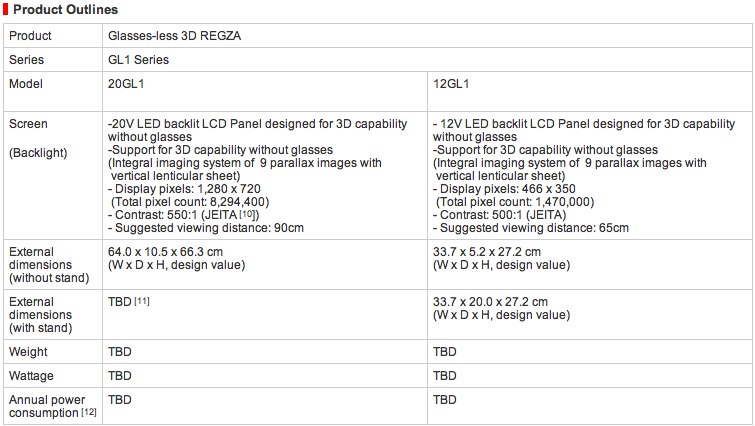Toshiba Glasses-Less 3D REGZA GL1 TVs Arriving In Dec 2010
Toshiba Japan has announced what it's calling the world's first 3D LCD TVs that don't require special glasses, though you'll need to have a relatively small living room to enjoy them. The Toshiba Glasses-less 3D REGZA GL1 Series will land in Japan from the end of 2010, and be available as the 12- inch 12GL1 and the 20-inch 20GL1.
The absence of special specs is thanks to a lenticular sheet that's placed over the LED backlit LCD panel, and which creates nine parallax images that can be seen when viewers are sat within a certain viewing zone. Toshiba recommend sitting 65cm away from the 12-inch display and 90cm away from the 90cm panel.
Neither will give you Full HD: the 20GL1 runs at 1,280 x 720 while the 12GL1 runs at a mere 466 x 350. No word on pricing at this stage, but despite the meager specifications we're guessing these will be expensive displays.
Press Release:
Toshiba Unveils World First[1] 3D LCD TVs without Dedicated Glasses-Toshiba's new Glasses-less 3D REGZA GL1 Series to be available from end of December -Tokyo—Toshiba Corporation (TOKYO: 6502) today unveiled the world's first[1] LCD TVs that offer comprehensive 3D[2] capabilities without any need for dedicated glasses. The new "Glasses-less 3D REGZA GL1" series offers two models with screen sizes specifically designed for personal use: the 20-inch 20GL1 and the 12-inch 12GL1. Both TVs will be available in Japan from the end of December.
The new 3D TVs with no need for glasses employ an integral imaging system[3] and a perpendicular lenticular sheet[4] to display smooth, natural images, and Toshiba's image processing technology to create nine parallax images[5] from the original content and create to 3D images. The result is precise rendering of high quality 3D images whatever the viewing angle within the viewing zone[2].
The 20GL1 integrates a high definition LED backlit LCD panel specially designed for 3D capability without any need for glasses that offers approximately four times the pixels of a standard Full HD panel. It also integrates the Cell REGZA Engine designed for 3D capability without glasses and based on the Cell Broadband Engine™[6] to deliver superior multimedia processing. The result of this combination is stunningly sharp, dynamic 3D images.
Toshiba will respond to various needs from the users for LCD TV with 3D capability. This will include larger screen models that use dedicated glasses and personal use LCD TVs without glasses, all offering dynamic, stunning image depth and high image quality. Toshiba will continue to draw on synergies of its semiconductor and image processing technologies to advance REGZA series as the cutting-edge of TV technology, and to create and deliver new value to the market by continuing to expand its line-up, and by anticipating and responding to user needs.
Product Outline
Product Series Model Screen Size Price Launch in Japan
Glasses-less
3D REGZA GL1 20GL1 20-inch Open December end
12GL1 12-inch Open December end
Background to Development
Toshiba introduced the REGZA series as state-of-the-art TVs that make full use of synergies between its semiconductor and image processing technologies. Originally a 2D platform, REGZA TVs now deliver 3D images with superb quality to achieve an unsurpassed 3D experience.
Current 3D TV is based on active shutter glasses that deliver separate images to the left and right eyes. However, the market wants TVs that deliver the 3D experience without dedicated glasses across all content. In responding to this, Toshiba has adopted an integral imaging system that reproduces smooth, natural stereoscopic pictures, without any need for dedicated glasses. The company has channeled its initial efforts into personal-use 3D LCD TVs without glasses and is now commercializing 12- and 20-inch models. With these new TVs, Toshiba will seek to lead the market in 3D TV without glasses and to further increase its market share.
Key Product Features
1. The technology of 3D capability without glasses reproduces smooth, natural high quality 3D images
The new Glasses-less 3D REGZA GL1 series employ an integral imaging system and perpendicular lenticular sheet that can display natural and smooth high quality 3D images.
The integral imaging systems is based on the principal of sampling and collecting form several directions the light reflected from an object, and then faithfully reproducing the light through the display to realize smooth, natural images. Until now, conventional 3D technology without glasses has produced a fall off in image resolution and increased blurring[7] that has prevented practical use. Toshiba employs an LED backlit LCD panel specially designed for 3D content that systematically aligns pixels, and has also adopted a perpendicular lenticular sheet in order to realize precise rendering and natural, high quality 3D images.
Toshiba's technology simultaneously delivers nine parallax images to the LCD panel and controls and optimizes light emission and direction from the center, right and left of the screen to secure a wide viewing angle. The result is optimized display of high quality 3D images whatever the position and angle to the screen of the viewer[2].
This technology is the recipient of the 21st Century Invention Prize for 2010, one of the National Commendations for Invention, from the HATSUMEI KYOKAI, Japan Institute of Invention and Innovation.
2. LCD panel designed for 3D capability without glasses
The 20GL1's high definition LED backlit LCD panel, specially designed for 3D capability without glasses, has approximately four times the pixels of a Full HD panel, approximately 829 million pixels. It can combine and display nine parallax images carrying information from nine images created in real time from a single frame. It transmits the final 3D image with a resolution of 1280 x 720 pixels.
Toshiba's LED backlight control system positions 1,440 LEDs directly under the LCD panel to realize bright 3D images. Moreover, each pixel can support the display of red green and blue (RGB) in a layout expressly designed for 3D imaging. Image data from each pixel is replicated nine times and the direction in which they are transmitted is controlled by the lenticular sheet. The result is smooth, natural 3D images that can be viewed from multiple angles without glasses.
The 12GL1 supports the same approach for approximately 147 million pixels and integrates an LED panel that can display 466 x 350 pixels.
The 20GL1 LCD panel is the fruit of research with Toshiba Mobile Display Co., Ltd. This was supported in part under the revised budget for FY2009 from the Ministry of Internal Affairs and Communications for "Research and Development on Glasses- Free 3D Image Technologies."
3. Newly developed engine designed for 3D capability without glasses
The 20GL1 integrates the Cell Broadband Engine™[6] and the Glasses-less 3D CELL REGZA Engine, newly developed multi-parallax conversion LSIs designed for superior multimedia processing. High speed arithmetic processing creates nine parallax images from original content and converts it to 3D images with real depth, allowing Toshiba to achieve precise rendering of natural, high quality 3D images.
For the 12GL1, the newly developed engine designed for 3D capability without glasses combined with Toshiba's image processing LSIs and multi-parallax LSIs creates the 3D image.
4. Focus on Environmental Considerations
(1) Integration of LED backlight
The Glasses-less REGZA GL1 Series TVs are environmentally conscious products that integrate energy-saving LED backlighting. The backlights are free of mercury, which occurs at trace levels in cold cathode fluorescent (CCFL) backlights.
(2) Energy-saving features
The 20GL1 offers a number of energy-saving features:
- Power consumption is controlled by maintaining optimum image brightness.
- Automatic stand-by if no command is received from the remote controller for approximately three hours.
- Automatic stand-by mode if, when the TV is set to external input, no signal is received for approximately 15 minutes.
(3) Effective use of resources
All components that use over 25g of plastic indicate the materials used and are designed for recycling. Use of polylactic resin, a biodegradable, vegetable-based plastic 100% derived from corn, contributes to reduced consumption of petroleum and to lower CO2 emissions.
(4) RoHS[8] and J-Moss[9] (Green Mark)compatible
The REGZA GL1 Series contributes to moves toward environmentally conscious products by achieving full compliance with the EU's RoHS and Japan's J-Moss.
About Toshiba Group Environmental Vision
Environmental Vision 2050 guides Toshiba Group in achieving a ten-fold increase in overall eco-efficiency by 2050, compared to 2000, in order to contribute to the future of a sustainable Earth as a "corporate citizen of planet Earth". Toward this goal, we promote initiatives aimed at realizing a world where people lead affluent lives in harmony with the Earth, based on the concept of three "Greens": Greening of Process (environmentally conscious manufacturing process), Greening of Products (environmentally conscious products), and Greening by Technology (contributing through environmental technology). Toshiba Group promotes its environmental initiatives under the global brand "Toshiba eco style."



